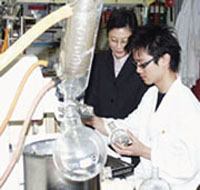.gif)
| Page 1 | |
| Q&A: Rules on multiple grants | |
| Biological and Chemical Sciences | |
| 'Brain gas' lead may stop stroke damage | |
| Molecules hold key to new-style sensors | |
| Bird flu probe finds hyperactive proteins | |
| Breakthrough may lead to cancer cure | |
| World-first biosensor tests food antibiotics | |
| Chinese herb leads to non-toxic malaria cure | |
![]()
Basic research into the behaviour of metal complexes has discovered what could lead to a new line of sensors for environmental and industrial use. Researchers led by Prof Vivian W W Yam, chair of chemistry at The University of Hong Kong, have demonstrated that the different ways molecules come together make them appear and luminesce in different ways.
 |
| Prof Yam with one of her students |
Square-planar platinum complex is used in experiments because of its open structure which allows molecules to more easily stack together.
“This is basic research so an end use is a long way off but, for example, it could be potentially used as a sensor to detect unhealthy levels of organic vapours in the air,” said Prof Yam.
.jpg) |
The colour of the light changes depending on how the molecules assemble or are packed together. Molecules that come together in a linear fashion appear green in colour (see illustration); molecules that assemble in sets of parallel pairs appear red in colour.
“It’s the same complex with the same molecular structure but the colour changes depending on their aggregation,” said Prof Yam.
The research is in a new branch of chemistry, supra-molecular chemistry, and concerns so-called weak metal-metal interactions, also referred to as non-covalent bonding interactions. Whereas the much stronger covalent bonds are characterised by the sharing of electrons between the atoms of molecules, non-covalent bonding interactions can be any of a variety of forces that hold molecules or parts of molecules together.
They also include hydrogen bonding, and hydrophobic forces. “In the past, little attention has been paid to these weak interactions,” said Prof Yam. “But, in fact, they are very important because combinations of weak interactions can actually give rise to enormous strength in the materials.” She added: “We’re trying to understand how these weak interactions play a role in affecting the assembly of different molecules and how they affect the colour of the complex itself.”
When red or green crystals of the platinum complexes were added to different organic solvents, for example, the colour of the solution turned from yellow through green to blue indicating different alignments of the molecules.
Principal Investigator
Prof Vivian W W Yam : wwyam@hku.hk
![]()